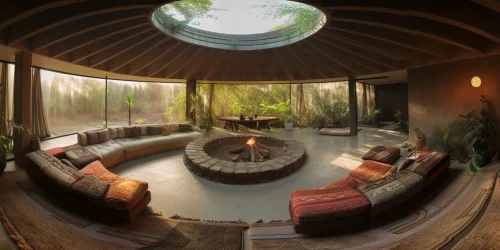
How Frosted Glass Enhances Privacy and Style in Modern Homes
December 27, 2024
What are fire resistant doors and how are they different from standard doors?
December 28, 2024Most of us have at any time in our lives dreamt of living in a place surrounded by nature. And because of urbanisation and technological changes, it is so hard to even think of it. But what if I say—you can have the experience of living surrounded by nature? Yes, you can go for a biophilic design. Before we jump into that, it's important to understand the biophilic meaning. Biophilic, also known as biophilia in design, is a human tendency to connect with other living beings and the natural environment.
What is Biophilic Design?
Biophilic design is a way to connect your life with nature. Here, homeowners with an architectural approach aim to connect themselves to the natural environment through the use of direct or indirect nature, space, and place conditions. One of the best examples of biophilic architecture is Antilia.
Source: Freepik
Elements of Biophilic Design
Biophilic design consists of 14 elements classified into three categories: nature in the space, natural analogues, and nature of the space.
1. Nature in the space incorporates space in design elements. Simply put, natural elements like plants and flowers will be there in a space background environment. It has 7 elements.
Source: Freepik
2. Natural analogues involve using materials, patterns, and designs that are inspired by nature. For example, furniture made with wood or stone finishes and wall art featuring leaf patterns. There are 3 elements in natural analogues.
Source: Freepik
3. Nature of the space focuses on designing spaces that feel like natural environments. For example, create pathways that lead to something intriguing, such as a garden (mystery). It is composed of four elements.
Source: Freepik
Here’s a table with simple explanations of each element of biophilic design:
Category | Element | Explanation |
Nature in the Space | 1. Visual Connection with Nature | Views of nature, like trees, plants, or gardens, are visible from windows. |
2. Non-Visual Connection with Nature | Engaging other senses like touch, smell, or hearing through natural sounds (like birdsong) or scents. | |
3. Non-Rhythmic Sensory Stimuli | Subtle and random natural movements, like leaves rustling or water rippling. | |
4. Thermal & Airflow Variability | Comfortable changes in temperature or mimicking natural outdoor environments. | |
5. Presence of Water | Including water features like fountains, aquariums, or reflecting pools for a calming effect. | |
6. Dynamic & Diffuse Light | Allowing natural light to change throughout the day, like sunlight filtering through curtains. | |
7. Connection with Natural Systems | Observing natural processes, like seasonal changes or the growth of plants, in your environment. | |
Natural Analogues | 8. Biomorphic Forms & Patterns | Using shapes and patterns inspired by nature, like spirals, honeycombs, or waves. |
9. Material Connection with Nature | The design incorporates natural materials, like wood, stone, or bamboo. | |
10. Complexity & Order | Creating intricate yet organised designs that resemble the balance found in nature. | |
Nature of the Space | 11. Prospect | Open spaces with wide views give a sense of safety and control. |
12. Refuge | Cosy, private areas where people can feel safe and relaxed. | |
13. Mystery | Adding intrigue by designing spaces with partially hidden elements or pathways leading to surprises. | |
14. Risk/Peril | Adding a touch of thrill, like a glass floor over a height, while ensuring it feels safe. |
Also read: 7 Stunning False Ceiling Design Ideas for Every Room in Your Home
Benefits of Biophilic Design
One of the primary benefits of biophilic design is that it provides mental health improvement. These designs have been shown to improve mood by lowering stress and anxiety levels. More such benefits of biophilic designs are discussed below:
Increases Productivity
According to research, having plants nearby can increase workplace creativity and productivity by up to 15%. And because biophilic designs bring you closer to nature, they can help you be more productive.
Enhances Aesthetic Appeal
The biophilic interior design incorporates natural light that creates visually pleasing spaces, leading to enhancements in aesthetic appeal for the home.
Also read: WPC Full Form: Understanding Features and Uses of WPC Doors
Better Air Quality
Colourful patterns and designs of the natural environment promote natural ventilation, which leads to improvement in the air quality of the biophilic design homes.
Energy Efficient
Biophilic designs use natural light and ventilation processes to reduce reliance on artificial lighting and air conditioning, which leads to lowering costs and improving energy efficiency.
Reduced Absenteeism and Fatigue
Nowadays, these are used as modern biophilic office designs, which are useful in reducing employee absenteeism, and not just that biophilic design materials are also good for reducing the fatigue of employees.
Final Thoughts
Having a dream of spending your life in nature? No worries; this can be possible with biophilic design. These designs offer you the comfort of living in a place surrounded by natural elements. And the most perfect thing about biophilic interior design is that it is also known for improving the health benefits of homeowners.
Also read: Frosted Window Film: Affordable Style and Privacy for Any Room
Frequently Asked Questions
What is the concept of biophilic design?
Biophilic design offers natural elements to improve the health of human beings. It focuses on connections with nature by using greenery, natural light, and organic materials to create healthier and more inspiring environments for people.
What are the 5 senses of biophilic design?
Biophilic design engages all five senses:
- Sight: Greenery and natural views.
- Sound: Gentle water sounds or bird songs.
- Smell: Aromas from plants or natural materials.
- Touch: Textures like wood or stone.
- Taste: Edible gardens or herbs.
What are the three pillars of biophilic design?
The three pillars of biophilic design are: nature in space, natural analogues, and nature of the space.
Who is the father of biophilic design?
Stephen Kellert is considered the father of biophilic design. He developed principles and frameworks for successfully integrating nature into architecture and design.
What are biophilic principles?
Biophilic principles guide the design process to focus on fostering human-nature connections. They include incorporating natural light, ventilation, greenery, and materials that reflect nature, aiming to improve physical, emotional, and mental well-being.











